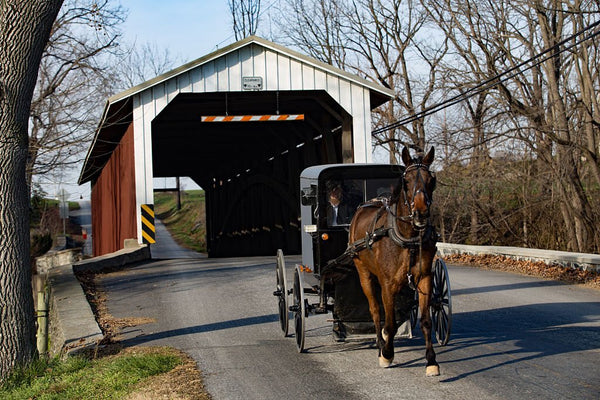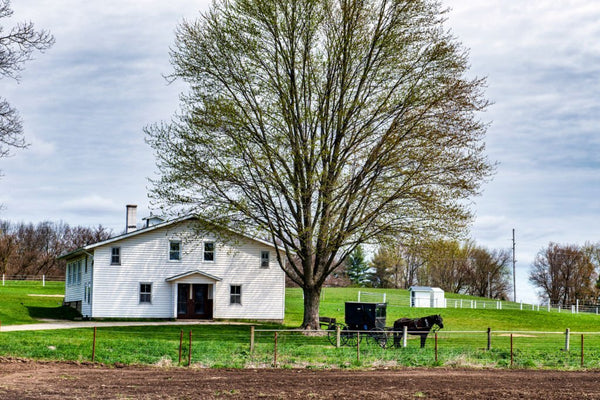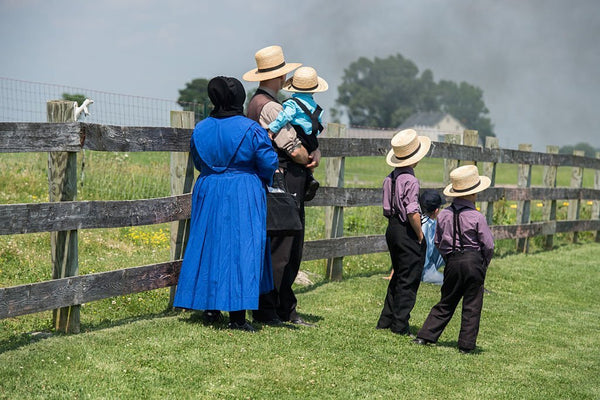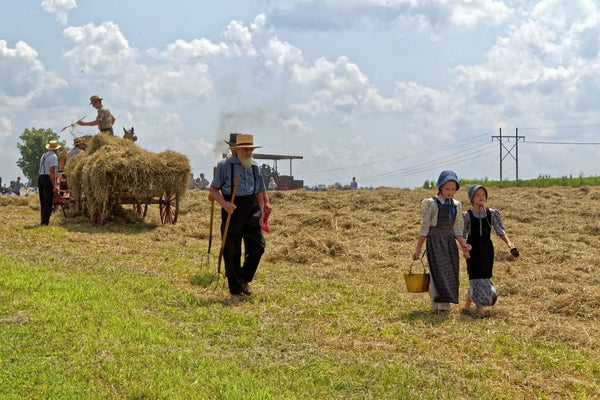Do you want to be able to explain the difference between Anabaptist vs Amish?
You’re in the right place.
Telling the difference between Amish and Anabaptist groups can be complicated. Many people are confused about who each group is and what they believe. Plus, some tricky overlaps may leave you feeling stumped.
The confusion doesn’t lie with just Anabaptists, either. Many people are confused as to where certain denominations end and the Amish begin. Are the Amish puritans? What’s the difference between Amish and Quaker?
In short, the Amish are a subgroup of the Anabaptist church. You could use the word “Anabaptist” as an umbrella term that refers to several different denominations.
This article will delve into the origins and beliefs of the Anabaptists and Amish people. We’ll also highlight the differences between the two groups.
What this article covers:
Who Are the Anabaptists?
The Anabaptists are an independent religious Christian sect. It formed in Europe due to their different ideologies from existing Christian groups.
Although they originated in Europe, today they are located across the globe.
Their main ideology is that people should be able to choose whether or not they are baptized into the church. For this reason, Anabaptists are baptized during adulthood rather than as a baby.
Additionally, their formation was to counter the dominating Catholic church at the time. Catholics are baptized as babies and Anabaptists disagreed with this practice.

Since their establishment in the 1950s, many subgroups of Anabaptists have been created. These include the Amish, Mennonites, Beachy, and many more.
So are the Amish Anabaptists? In short – yes and no. The Amish ancestors were Anabaptists who separated themselves from the group in 1693 under the leadership of Jakob Ammann.
Let’s have a closer look into the origins of the Anabaptists so we can better understand the difference between the Amish and Anabaptists.
Anabaptist Origins
The Anabaptists are a Christian movement that originates from the Radical Reformation in early 16th Century Switzerland. In 1525, they separated themselves from the mainstream Protestants because they believed the church should be independent of the state.
They were some of the earliest people to call for a separation between religion and government. At the time, this was radical thinking.
What’s more, they emphasized the importance of the Bible over the government. Therefore, they followed its teachings rather than the law. During this period, this was a widely unpopular belief.

As a result of these two uncommon beliefs, the Anabaptists angered religious leaders and civil officials. Subsequently, they were persecuted. Many were executed by being burned at the stake or decapitated. Many more were tortured and imprisoned.
This led to the belief amongst Anabaptists that the true church would forever remain a minority. Because of this, they have a long history of separation from the state. Even today, Anabaptists and their denominations see themselves as separate from the rest of society.
The early Anabaptist culture was categorized by small, scattered groups. Their movement is the foundation of many other well-known Christian subgroups today, such as the Brethren groups, Amish, Mennonites and Hutterites.
So are Amish Anabaptists? Originally, yes, but today they are their own independent denomination.
Although these two groups vary in their practices and interpretations of faith, they all have the same origins in the Anabaptist church. In 1527, the Schleitheim Confession was drawn up by Michael Sattler. This document carefully outlines the Anabaptist principles which are still reigning today.
Anabaptist Beliefs
As a Christian movement, the Anabaptists emphasize the teachings of Jesus Christ. In particular, they focus on the Sermon on the Mount.
As mentioned, one of the main distinguishing beliefs between the Anabaptists and other Christian groups is baptism. Mainstream Christians are baptized as babies. However, Anabaptists believe that a person should be able to choose from their free will whether they want to follow the teachings of the church.

For this reason, Anabaptists allow adults to decide if they want to be baptized and join the church. Hence, the name Ana-baptists which means rebaptized.
Anabaptists are also firm proponents of the separation of church and state. They have a strong conviction that the church shouldn’t be involved in worldly issues or hold political power because power and greed are contrary to God’s Will.
For them, maintaining the church’s integrity and preventing corruption from occurring are mutually exclusive.
How Do the Amish Differ From Anabaptists?
Beliefs
As mentioned, the Anabaptist movement was created to oppose the Catholic church. Therefore, they’re on the more radical side of the Protestants.
This should answer the question “Are Amish people catholic?” No, the Amish aren’t Catholics because they originate from the Anabaptist church.
So, are the Amish Anabaptists? This is a tricky question. Originally, yes, the Amish were an Anabaptist denomination, but today they’re a separate group.
So what’s the difference between them? And do they have any similarities?
The Amish and Anabaptists have quite similar beliefs. For example, they both subscribe to nonresistance. They’re wholly against promoting violence in all of its forms. This extends to military service, so neither group participates in the United States army.
Similarly, shunning is practiced amongst both the Amish and the Anabaptist communities. Shunning is a form of harsh punishment for someone who has broken the community rules. The individual is rejected from society, and interaction immediately ceases between the two sides.
However, the Amish separated themselves from the Anabaptists due to disagreements about shunning. The Amish believed it should be a stricter, harsher punishment. As a result, they formed their own denomination.
Both groups are Christians and therefore celebrate the same holidays. Amish people often make Easter baskets during the spring months.
Traditions and Practices
Both the Amish and Anabaptists have interesting, long-standing traditions. They both share the tradition of adult baptism. Amongst the Amish, this usually occurs after Rumspringa, when the young adult decides to join the church.
Anabaptists typically adhere to the practice of foot-washing, a common practice during biblical times designed to promote humility and encourage goodwill in the community. During this act, they believe that they’re obeying the Lord’s teachings as well as imitating Jesus Christ, who famously washed the feet of his Apostles.
The Amish also practice foot-washing twice during the year, and this communal act perfectly demonstrates how the Amish emphasize the family-oriented, simple, and traditional way of life. Another excellent example is that they often organize group picnics after church where they use homemade picnic baskets and pie carriers. Generally speaking, most Amish people enjoy spending time making homemade crafts such as sewing baskets, wicker laundry baskets, and wicker baskets for shelves.
Moreover, the holy kiss, sometimes called the kiss of peace, highlights the importance of community living. It’s a shared practice between the Anabaptists and the Amish to signify a blessing of peace to the receiver.
Types of Amish
To make things a little more complicated, there are several different groups of Amish people. All Amish adhere to the Ordnung which refers to the unwritten rules that govern their lifestyles. However, interpretations vary considerably between Amish groups.
Let’s have a look at some of the main groups.
Usually, the word Amish refers to Old Order Amish. They’re considered to be the most conservative subgroup. And with over 350,000 Old Order Amish living in the US, they are the largest of all Amish groups.
In 1966, the New Order Amish sect was formed as a response to differing ideas. They believed that methods of farming should be more modern and they wanted to relax courting standards for young people.
Most of the Amish groups prohibit the use of motor vehicles and instead use a horse and buggy to get around. But are they all the same?
No, each subgroup has its own different rules regarding the color and style of the buggy. For example, some groups allow the use of signs and lights on their buggies while others strictly prohibit them.
What is Brethren Amish? This is a unique movement created from the Evangelical, Mennonite, and Anabaptist movements. Established in Ukraine in 1860, today they’re found in India, the Democratic Republic of Congo, South East Asia, Canada, and the US.

Conclusion
So, how can we sum up Anabaptist vs Amish?
The Amish separated from the Anabaptist movement due to disagreements on beliefs. Although both groups have many similarities and share multiple beliefs, the Amish have distinguished themselves from the Anabaptists.
This was due to a difference of opinions regarding social shunning rules. The Amish believed the punishment should be stricter and subsequently established their own denomination.
Today, the Amish still share many similarities with the Anabaptists. They have the same traditions, practices, and beliefs, but live separate lives. While there was a tangible split between the two communities, Anabaptists and the Amish share common roots, and while they differ in some practices, they generally live in harmony and have a respectful relationship.
Did You Find Our Blog Helpful? Then Consider Checking:
- Mormon vs Amish
- Dunkards vs Amish
- Shaker vs Amish
- Amish vs Mennonite Buggy?
- Amish Seventh-Day Adventists
- Mennonite vs Amish
- Old Order Mennonite vs Amish
- Mennonite vs Amish Clothing
- Are Amish Polygamists
- Amish History
- What Language Does the Amish Speak
- Amish Wedding Foods
- What Age Do Amish Get Married
- Traditional Amish Wedding Dress
- What Do the Amish Wear to Bed




